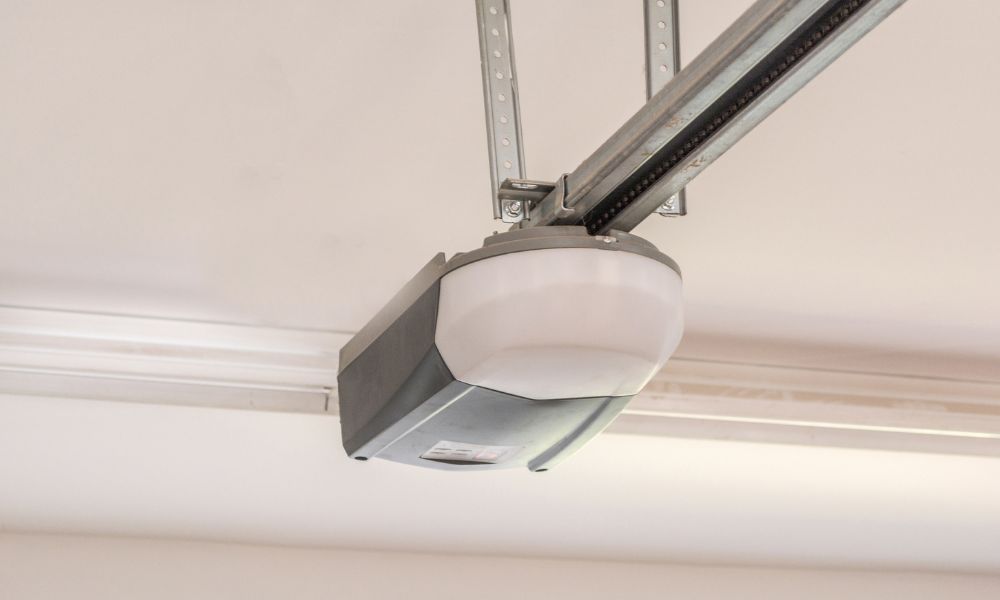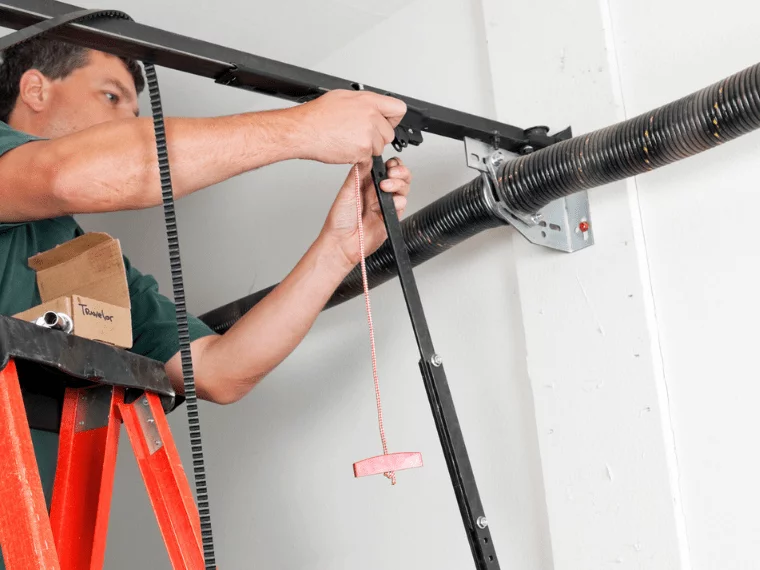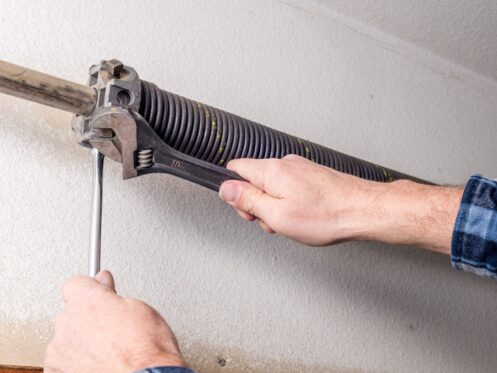A garage door that’s out of alignment or not functioning smoothly can be a major inconvenience.
Whether it’s failing to open or close, making noise, or leaving gaps, adjusting your garage door can often fix the problem.
This guide will walk you through the steps to adjust your garage door and ensure it operates properly.
How to adjust a garage door?
Adjust your garage door by inspecting the tracks, springs, and rollers. If the door isn’t opening or closing properly, adjust the tension or track alignment to get it running smoothly. For homeowners needing garage door repair in Kaneville IL, addressing these common issues early can help avoid costly repairs down the line.
Key Takeaways
- Regular garage door maintenance, including adjustments, can prevent major issues and extend the life of your door.
- Proper adjustment is important for smooth operation, safety, and preventing damage to the door and opener.
- Common adjustments include realigning the tracks, tightening hardware, and adjusting spring tension.
Understanding the Components of Your Garage Door

Before you begin adjusting your garage door, it’s important to understand the various components involved in its operation.
A garage door that is out of alignment or not functioning smoothly can be a significant inconvenience.
Whether it’s failing to open or close properly, making excessive noise, or leaving gaps, adjusting your garage door can often resolve the issue.
This guide will walk you through the necessary steps to adjust your garage door and ensure it works correctly.
This will help you identify what needs to be adjusted and ensure a smooth process. The basic parts of a typical garage door include:
- Tracks: The metal pathways that the rollers follow when the door moves up and down.
- Rollers: Small wheels that move along the tracks and help the door open and close smoothly.
- Springs: Torsion or extension springs help balance the door’s weight and assist in its movement.
- Cables: Steel cables are responsible for lifting the door.
- Garage Door Opener: The motorized unit that controls the opening and closing of the door.
Now that you know what each part does, let’s explore how to adjust the door.
Step 1: Inspect the Door and Tracks
Before making any adjustments, start by inspecting the door and tracks for any visible issues. Look for:
- Bent or misaligned tracks: The tracks should be parallel and free from bends or dents.
- Loose hardware: Ensure that all bolts, nuts, and screws are tight.
- Debris in the tracks: Dust, dirt, or small objects can obstruct the rollers and prevent smooth movement.
How to fix it:
Use a wrench to tighten any loose bolts or screws, If the tracks are misaligned, gently tap them back into place with a rubber mallet.
Clean the tracks with a dry cloth or vacuum to remove any debris.
Step 2: Adjust the Track Alignment
If the tracks are misaligned, your garage door will not move properly, and it may even get stuck. To adjust the tracks:
- Loosen the bolts holding the tracks: Using a wrench, loosen the bolts that secure the tracks to the frame.
- Realign the tracks: Using your hands or a mallet, carefully realign the tracks so they are perfectly vertical and parallel to each other.
- Tighten the bolts: Once the tracks are aligned, retighten the bolts to secure them in place.
- Tip: Be careful not to overtighten the bolts, as this can cause the tracks to bend or warp.
Step 3: Adjust the Rollers
Over time, the rollers can wear out or become misaligned, causing the door to be noisy or not move smoothly. To adjust the rollers:
- Check the rollers for wear: Inspect the rollers for signs of wear, such as cracks or flat spots. If the rollers are damaged, they should be replaced.
- Lubricate the rollers: Apply a lubricant specifically designed for garage doors to keep the rollers moving smoothly.
- Adjust the roller brackets: If the rollers are misaligned, adjust the roller brackets to ensure they are positioned correctly on the tracks.
Inspect and Replace the Rollers
Worn-out rollers can cause the door to become misaligned, creating gaps. Replacing old rollers can improve the movement of the door and help close the gaps.
How to Do It: Start by opening the garage door to its halfway position. Use a wrench to remove the old rollers from the tracks.
Replace the worn-out rollers with new ones, ensuring they fit securely in the tracks. Lubricate the new rollers to ensure smooth operation.
Step 4: Adjust the Garage Door Springs
The garage door springs play a critical role in balancing the door’s weight. If they’re either too tight or too loose, it can cause the door to struggle during opening or closing.
Learning how to check garage door spring tension can help you identify if there’s an issue early on. Since adjusting them involves high tension and potential risk, it’s safer to call a professional if you’re not confident.
However, if you feel confident in your abilities, follow these steps to adjust the springs:
1. For Torsion Springs:
- Locate the torsion spring above the garage door.
- Use a winding bar to adjust the tension. Insert the bar into the winding cone and turn it carefully. Rotate the bar in small increments to avoid over-tightening.
2. For Extension Springs:
- Locate the extension springs on either side of the door.
- Adjust the spring’s length by moving the spring hook along the track or changing the tension with an adjustable wrench.
Tip: Always adjust springs in small increments. Too much tension can cause the door to become unbalanced and damage the system.
Step 5: Check and Adjust the Cables
The cables play a critical role in helping the door move smoothly. If the cables are frayed or loose, they can cause the door to become misaligned.
- Inspect the cables: Look for any signs of fraying or damage. If the cables are worn, they need to be replaced.
- Adjust cable tension: If the cables appear loose, you can adjust the tension by tightening the cable drum on each side of the door.
Tip: If the cables appear damaged or if you are unsure how to adjust them, it’s best to call a professional garage door repair service for help.
Step 6: Test the Door’s Balance
After making the necessary adjustments, you’ll want to check the balance of the garage door.
A balanced door ensures smooth operation and prevents excessive wear on the opener. To check the balance:
- Disconnect the opener: Pull the manual release cord to disconnect the opener from the door.
- Manually lift the door: Lift the door halfway and release it. If the door stays in place, the springs are properly balanced.
If the door falls or rises on its own, the springs may need to be adjusted.
Check the Door’s Balance
If your garage door is out of balance, it can cause uneven gaps when it’s closed. A door that’s too heavy on one side may not close properly, leaving gaps.
How to Do It: To check if the door is balanced, open it halfway and then release the door. If the door stays in place, it’s properly balanced.
If the door moves up or down by itself, the springs may need adjustment.
Tip: If the door doesn’t stay in place, adjust the tension on the springs or consult a professional for assistance.
Step 7: Adjust the Limit Switches
Limit switches control the points at which the garage door opens and closes. If the door isn’t opening or closing fully, the limit switch may need adjustment.
- Locate the limit switches: These are typically found on the garage door opener near the motor.
- Adjust the limit switches: Use the adjustment screws on the opener to set the door’s stopping point. Turn the screws clockwise to shorten the opening or counter clockwise to extend it.
Professional Help: When to Call a Technician

While many adjustments can be done by yourself, certain issues, such as spring adjustments, damaged cables, or malfunctioning openers, require professional expertise.
If you’ve tried all of the above solutions and the door is still not functioning properly, it’s time to call a professional. For reliable garage door repair in Wasco, IL, a certified technician can inspect the entire system, diagnose the issue, and provide safe, effective repairs to restore your garage door’s functionality.
Frequently Asked Questions
1. How often should I adjust my garage door?
It’s recommended to inspect and adjust your garage door at least once a year. Regular maintenance helps prevent major issues and extends the lifespan of the door and its components.
2. Is it safe to adjust the garage door springs myself?
Adjusting garage door springs can be dangerous due to the high tension involved. If you’re not experienced, it’s best to hire a professional to adjust or replace the springs.
3. Can I fix a misaligned garage door myself?
Yes, you can fix a misaligned garage door by adjusting the tracks, rollers, and springs. However, if the problem is more complex, it may be best to call a professional for help.
Conclusion
Adjusting your garage door is a manageable task that can prevent bigger issues down the line.
By following the steps outlined above, you can ensure your garage door operates smoothly and efficiently.
Regular maintenance, such as lubricating the moving parts, adjusting the tracks, and checking the springs, can extend the life of your door and prevent costly repairs.
If the problem persists or involves complex components like broken springs or cables, don’t hesitate to seek professional help to ensure the safety and longevity of your garage door system.

